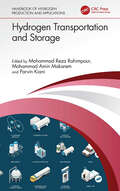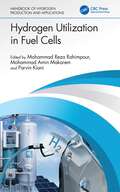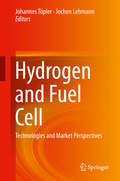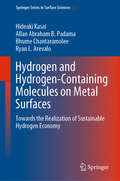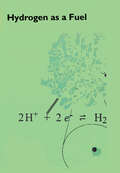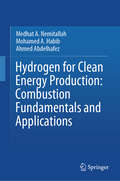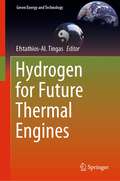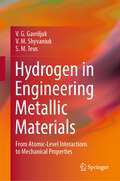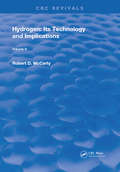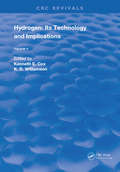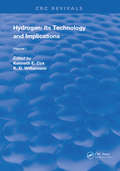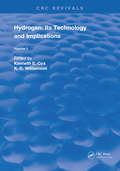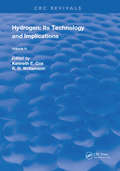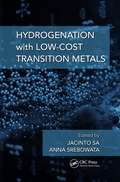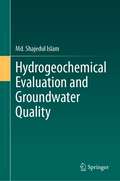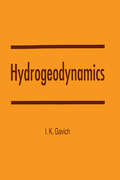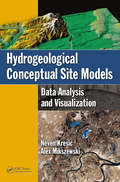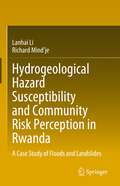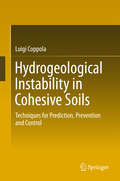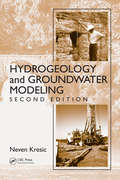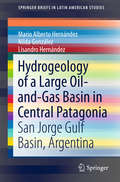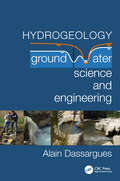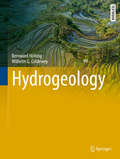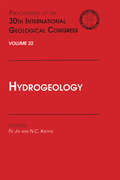- Table View
- List View
Hydrogen Transportation and Storage
by Mohammad Reza Rahimpour Mohammad Amin Makarem Parvin KianiThe success of hydrogen energy markets depends on developing efficient hydrogen storage and transportation methods. Hydrogen may be stored in various ways, including compression, liquefaction, adsorption, hydrides, and reformed fuels. Hydrogen’s application, transport method, storage time, and other factors all have an impact on the technology choices available for its long‑term storage. This book comprehensively reviews hydrogen storage and transportation technologies along with related safety hazards and challenges. Introduces hydrogen storage and transportation materials and standards Includes miscellaneous hydrogen storage methods Covers different hydrogen transportation technologies Comprehensively describes hydrogen storage and transportation safety considerations Provides economic assessments and environmental challenges related to hydrogen storage and transportation Part of the multivolume Handbook of Hydrogen Production and Applications, this standalone book guides researchers and academics in chemical, environmental, energy, and related areas of engineering interested in development and implementation of hydrogen production technologies.
Hydrogen Utilization in Fuel Cells
by Mohammad Reza Rahimpour Mohammad Amin Makarem Parvin KianiHydrogen Utilization in Fuel Cells introduces the fundamentals, characteristics, and applications of fuel cells, materials used, the role of hydrogen in different fuel cell types, and applications of fuel cells in transportation and small portable and stationary power systems. Introduces the electrochemistry and thermodynamics of fuel cells Provides an overview of fuel cells materials Discusses applications of fuel cells in transportation and energy systems Describes the role of hydrogen in various fuel cells Details the kinetics, performance, stability, and environmental challenges of fuel cells Part of the multivolume Handbook of Hydrogen Production and Applications, this stand-alone book guides researchers and academics in chemical, environmental, energy, and related areas of engineering interested in development and implementation of hydrogen production technologies.
Hydrogen and Fuel Cell
by Johannes Töpler Jochen LehmannThis book introduces readers to hydrogen as an essential energy carrier for use with renewable sources of primary energy. It provides an overview of the state of the art, while also highlighting the developmental and market potential of hydrogen in the context of energy technologies; mobile, stationary and portable applications; uninterruptible power supplies and in the chemical industry. Written by experienced practitioners, the book addresses the needs of engineers, chemists and business managers, as well as graduate students and researchers.
Hydrogen and Hydrogen-Containing Molecules on Metal Surfaces: Towards the Realization of Sustainable Hydrogen Economy (Springer Series in Surface Sciences #71)
by Hideaki Kasai Allan Abraham Padama Bhume Chantaramolee Ryan L. ArevaloThis book is dedicated to recent advancements in theoretical and computational studies on the interactions of hydrogen and hydrogenated molecules with metal surfaces. These studies are driven by the development of high-performance computers, new experimental findings, and the extensive work of technological applications towards the realization of a sustainable hydrogen economy. Understanding of the elementary processes of physical and chemical reactions on the atomic scale is important in the discovery of new materials with high chemical reactivity and catalytic activity, as well as high stability and durability. From this point of view, the book focuses on the behavior of hydrogen and hydrogenated molecules on flat, stepped, and reconstructed metal surfaces. It also tackles the quantum mechanical properties of hydrogen and related adsorbates; namely, molecular orbital angular momentum (spin) and diffusion along the minimum potential energy landscape on metal surfaces. All of these profoundly influence the outcomes of (1) catalytic reactions that involve hydrogen; (2) hydrogen storage in metals; and (3) hydrogen purification membranes. Lastly, it surveys the current status of the technology, outlook, and challenges for the long-desired sustainable hydrogen economy in relation to the topics covered in the book.
Hydrogen as a Fuel: Learning from Nature
by Robert Robson Richard Cammack Michel FreyThere continues to be widespread interest in the applications of hydrogen as a clean fuel and its potential for local electricity production and use in transport. Recent years have seen a variety of breakthroughs in our understanding of the nature, structure, and biosynthesis of hydrogenases. This book is a timely description of these developments,
Hydrogen for Clean Energy Production: Combustion Fundamentals and Applications
by Medhat A. Nemitallah Mohamed A. Habib Ahmed AbdelhafezThe book fills the existing gap in the literature on clean and hydrogen combustion technologies for industrial applications. This gas is created due to the absence of a comprehensive textbook that covers such kinds of developments. This book can be used as a textbook for graduate-level courses in the areas of clean and hydrogen combustion and as a reference book for short courses to be offered to mechanical and aerospace engineers and young researchers worldwide. The book chapters consider investigating clean and hydrogen combustion techniques for different applications based on experimental measurements along with detailed numerical simulations. Detailed descriptions of the different numerical models are presented for given applications to solve for the flow/flame fields, which are very important, especially for beginners and undergraduate students in the fields of clean and hydrogen combustion.
Hydrogen for Future Thermal Engines (Green Energy and Technology)
by Efstathios-Al. TingasThis book explores the potential of hydrogen combustion in thermal engines and serves as a foundation for future research.Hydrogen, a well-established energy carrier, has been used in internal combustion engines for centuries, but despite progress and industry interest, hydrogen engines have yet to reach mass production. In light of recent efforts to combat climate change with clean energy and environmentally-friendly technologies, the use of hydrogen in thermal engines is gaining momentum.This book examines the unique challenges of hydrogen combustion due to its wide flammability limits, high auto-ignition temperature, and high diffusivity. It reviews current knowledge on the fundamental and practical aspects of hydrogen combustion and considers current developments and potential future advancement.
Hydrogen in Engineering Metallic Materials: From Atomic-Level Interactions to Mechanical Properties
by V. G. Gavriljuk V. M. Shyvaniuk S. M. TeusThis book analyzes the effect of hydrogen on the atomic-level interactions in metals, detailing the corresponding changes in the physical properties of crystal lattice defects, diffusion, and phase transformations in metallic materials as a result of hydrogen loading. It presents a novel derivation of the structure of stacking faults, the mobility of dislocations, and short-range atomic order in hydrogen-infused metallic alloys based on the change in the concentration of free electrons. It reviews the current hypotheses behind hydrogen embrittlement of iron-, nickel, and titanium-based alloys, focusing on the phenomenon of hydrogen-enhanced localized plasticity and taking into account inherent atomic states in the alloys and other effects due to hydrogen loading. Finally, the book analyzes the use of hydrogen as an interim alloying element in the technological processing of titanium alloys, discussing the necessary preconditions for hydrogen-enhanced plasticity of metals. This book is an excellent resource for graduate students, academic researchers, and practicing engineers involved in the development of advanced hydrogen-resistant metallic materials.
Hydrogen: Hydrogen Properties - Volume III
by CoxVolume II of this series provides detailed design information on systems necessary for the storage, transfer, and transmission of gaseous and liquid hydrogen.Cost factors, technical aspects, and models of hydrogen pipeline systems are included together with a discussion of materials for hydrogen service. Metallic hydride gaseous storage systems for the utility and transportation industry are covered in detail, and the design Dewars and liquid hydrogen transfer systems are examined.This series in 5 volumes represents a serious attempt at providing information on all aspects of hydrogen at the postgraduate and professional level. It discusses recent developments in the science and technology of hydrogen production; hydrogen transmission and storage; hydrogen utilization; and the social, legal, political environmental, and economic implications of hydrogen‘s adoption as an energy medium.
Hydrogen: Implication of Hydrogen Energy - Volume V
by Kenneth E. Cox K.D. WilliamsonVolume V of this series is primarily concerned with the nontechnical aspects of hydrogen. Economics of hydrogen energy systems will play a major part in determining the time frame for hydrogen‘s adoption. Cost analyses of such systems with return on investment considerations are surveyed from the point of view of production, transmission, and storage of hydrogen. The environmental, political, social, and legal implications of new secondary energy forms such as hydrogen are discussed with reference to governmental energy policy, the social costs of energy production and use, and the public‘s acceptance of a hydrogen energy medium.This series in 5 volumes represents a serious attempt at providing information on all aspects of hydrogen at the postgraduate and professional level. It discusses recent developments in the science and technology of hydrogen production; hydrogen transmission and storage; hydrogen utilization; and the social, legal, political environmental, and economic implications of hydrogen‘s adoption as an energy medium.
Hydrogen: Production Technology - Volume I
by R I CoxVolume I of this series discusses such topics as hydrogen production from fossil fuels, nuclear energy, and solar energy. Hydrogen production technology from water by traditional methods such as water electrolysis and newer attempts to split water thermochemically are included with details of current research efforts and future directions.This series in 5 volumes represents a serious attempt at providing information on all aspects of hydrogen at the postgraduate and professional level. It discusses recent developments in the science and technology of hydrogen production; hydrogen transmission and storage; hydrogen utilization; and the social, legal, political environmental, and economic implications of hydrogen‘s adoption as an energy medium.
Hydrogen: Transmission and Storage - Volume II
by Kenneth E. Cox K.D. WilliamsonVolume II of this series provides detailed design information on systems necessary for the storage, transfer, and transmission of gaseous and liquid hydrogen.Cost factors, technical aspects, and models of hydrogen pipeline systems are included together with a discussion of materials for hydrogen service. Metallic hydride gaseous storage systems for the utility and transportation industry are covered in detail, and the design Dewars and liquid hydrogen transfer systems are examined.This series in 5 volumes represents a serious attempt at providing information on all aspects of hydrogen at the postgraduate and professional level. It discusses recent developments in the science and technology of hydrogen production; hydrogen transmission and storage; hydrogen utilization; and the social, legal, political environmental, and economic implications of hydrogen‘s adoption as an energy medium.
Hydrogen: Utilization of Hydrogen - Volume IV
by Kenneth E. Cox and K. D. WilliamsonVolume IV of this series covers the present and future uses of hydrogen. Hydrogen has been suggested as a prime candidate for both air and surface transportation. Both present and future domestic and industrial applications of hydrogen are surveyed. Important to all of these applications are the safety considerations in the use of hydrogen to allow for public acceptance of hydrogen‘s role as an energy medium.This series in 5 volumes represents a serious attempt at providing information on all aspects of hydrogen at the postgraduate and professional level. It discusses recent developments in the science and technology of hydrogen production; hydrogen transmission and storage; hydrogen utilization; and the social, legal, political environmental, and economic implications of hydrogen‘s adoption as an energy medium.
Hydrogenation with Low-Cost Transition Metals
by Jacinto Sa Anna SrebowataHydrogenation with Low-Cost Transition Metals describes recent developments in the preparation of catalysts and their catalytic abilities in chemoselective hydrogenation for the production of fine chemicals and pharmaceutical compounds. Emphasizing the use of low-cost metals (Cu, Ni, Fe, and Ag) that are often present in the form of nanoparticles, the book provides valuable reaction mechanism schemes, engineering solutions, and perspective for the field.
Hydrogenosomes and Mitosomes: Mitochondria Of Anaerobic Eukaryotes (Microbiology Monographs #9)
by Jan Tachezy"Hydrogenosomes and Mitosomes: Mitochondria of Anaerobic Eukaryotes" provides a summary of the current knowledge of these organelles which occur in unicellular, often parasitic organisms, including human pathogens. These organelles exhibit a variety of structures and functions. This work describes properties such as protein import, structure, metabolism, adaptation, proteome and their role in drug activation and resistance. Further topics include organelle evolution and biogenesis.
Hydrogeochemical Evaluation and Groundwater Quality
by Md. Shajedul IslamThis book comprehensively discusses the methods and practices for evaluating geochemical processes in aquifer groundwater. Possible occurrence and mechanisms of rock-water interaction, trace metal mobilization, thermodynamic explanation, actions of aquifer CO2, pollution sources, geogenic influencing factors, and isotope dilution methods are the primary areas of focus. These water quality variables are analyzed using a variety of logical/theoretical explanations, statistical techniques, and experimental procedures to determine the suitability of groundwater for drinking, irrigation, and other industrial purposes. The work is an important addition to hydrogeochemical literature since many existing indexing methods for the assessment of water quality are very old and have some degree of limitation. The book will be a useful resource for students, lecturers, and researchers working in the fields of hydrogeochemistry, hydrology, water pollution, and groundwater quality.
Hydrogeodynamics
by I.K. GavichThis text focuses particularly on the growing interest in hydrodynamic principles of the study of underground waters, new methods of eco-based hydrogeodynamic analysis, and the estimation of the quantity of infiltration water transfer. The author also discusses aspects of mass transfer by subsurface water flow in the light of molecular kinetics, and examines a new apporach to investigating the slow movements of groundwater at the deep zones of the hydrolithosphere.
Hydrogeological Conceptual Site Models: Data Analysis and Visualization
by Neven Kresic Alex MikszewskiA reference for students, researchers, and environmental professionals, Hydrogeological Conceptual Site Models: Data Analysis and Visualization explains how to develop effective conceptual site models, perform advanced spatial data analysis, and generate informative graphics for applications in hydrogeology and groundwater remediation. Written by e
Hydrogeological Hazard Susceptibility and Community Risk Perception in Rwanda: A Case Study of Floods and Landslides
by Lanhai Li Richard Mind’jeThis book employs qualitative and quantitative methods to assess and scrutinize the impacts of climatic, topographic, land use, hydrologic and geologic factors on the hydrogeological disasters particularly flood and landslide in Rwanda. The hydrogeological hazard susceptibility and its spatial distribution is also mapped by integrating geospatial techniques and mathematical modeling approach through remote sensing and Geographical Information System (GIS). On the other hand, questionnaires and interview are used to evaluate the community's perception on the risk of hazards. The results unveiled different zones most susceptible to the incidence of both hazards as well as their main contributing factors. Furthermore, the results revealed that the government is perceived as responsible for all mitigation measures instead of being a shared responsibility, a perception that may also contribute to the increase in susceptibility. Therefore, it is necessary to deliver the extent of disaster-related courses and trainings in both schools (from primary to tertiary level) and local community members, which helps improving the public's awareness, understanding and ability by providing a new perspective toward disaster prevention and reduction. The book provides a reference for interested readers to understand the natural and human geography of Rwanda, the distribution of hydrogeological disasters, and the policy-making of disaster prevention and reduction.
Hydrogeological Instability in Cohesive Soils: Techniques For Prediction, Prevention And Control
by Luigi CoppolaThis book discusses techniques for predicting, preventing and controlling the hydrogeological instability of slopes consisting of cohesive soils. The proposed methodology is practical and innovative, and assumes a dynamic valence in defining the deformation process of underground failure as well as its activation through the assumption of a four-dimensional space-time continuum. This latter aspect is crucial for predicting a landslide in time to control it. At present, predicting, preventing and controlling hydrogeological instability in cohesive soils relies on mathematical modelling using specific software, the predictive reliability of which is rather deficient. Such modelling is based upon deterministic processes, which are entirely unsuitable for dealing with the complexity of vital processes occurring during the genesis of a landslide. In this work, the three-dimensional vision of a landslide as a set of distinct and independent phenomena is abandoned and the prediction and prevention of hydrogeological instability is pursued through the alternative of an indivisible totality of natural phenomena that includes the time factor. The book is of interest to graduates and researchers of applied geology, geotechnical, environmental and civil engineering, as well as professionals in the fields of hydrogeology and natural hazards.
Hydrogeology and Groundwater Modeling
by Neven KresicCoupling the basics of hygrogeology with analytical and numerical modeling methods, Hydrogeology and Groundwater Modeling, Second Edition provides detailed coverage of both theory and practice. Written by a leading hydrogeologist who has consulted for industry and environmental agencies and taught at major universities around the world, this unique
Hydrogeology of a Large Oil-and-Gas Basin in Central Patagonia
by Mario Alberto Hernández Nilda González Lisandro HernándezThis book analyzes the most important geohydrological aspects of the San Jorge Gulf Basin (Chubut and Santa Cruz provinces, Argentine Patagonia), with a particular focus on the physical and hydrodynamic characteristics of the system. Discovered in 1907, the San Jorge Gulf Basin was the first petroleum and gas-producing basin in Argentina. It is also one of the most important areas with real prospects for non-conventional exploitation (shale oil-gas). After characterizing the hydroclimatic background (hydrometeorological parameters and water balance), the book describes the main physical aspects: geomorphology, soils and surface as well as subsoil geology, especially lithology, structures, stratigraphy and hydrogeology.
Hydrogeology: Groundwater Science and Engineering
by Alain DassarguesThis text combines the science and engineering of hydrogeology in an accessible, innovative style. As well as providing physical descriptions and characterisations of hydrogeological processes, it also sets out the corresponding mathematical equations for groundwater flow and solute/heat transport calculations. And, within this, the methodological and conceptual aspects for flow and contaminant transport modelling are discussed in detail. This comprehensive analysis forms the ideal textbook for graduate and undergraduate students interested in groundwater resources and engineering, and indeed its analyses can apply to researchers and professionals involved in the area.
Hydrogeology: Introduction To Applied Hydrogeology (Springer Textbooks in Earth Sciences, Geography and Environment)
by Bernward Hölting Wilhelm G. ColdeweyThis textbook provides a complete introduction to Hydrogeology. It is a comprehensive reference for earth science professionals involved in groundwater exploitation as well as for geotechnical engineers. This English translation of the German textbook "Hydrogeologie" by Hölting & Coldewey, which has been published in its 8th edition, provides insights into the sources and reservoirs of groundwater, the dynamics of fluid flow, and the physical and chemical composition of groundwater. It also gives an overview about the economic value of groundwater and its exploitation and use. A consistent use of the internationally accepted SI units as well as the formula symbols in the text contributes to the understandability.
Hydrogeology: Proceedings of the 30th International Geological Congress, Volume 22
by Fei JinThis book is a collection of papers presented in the symposia, held in Beijing, on hydrogeology. The papers deal with different topics providing information on some problems on riverside groundwater, assessment of groundwater contamination, and groundwater protection strategy.
